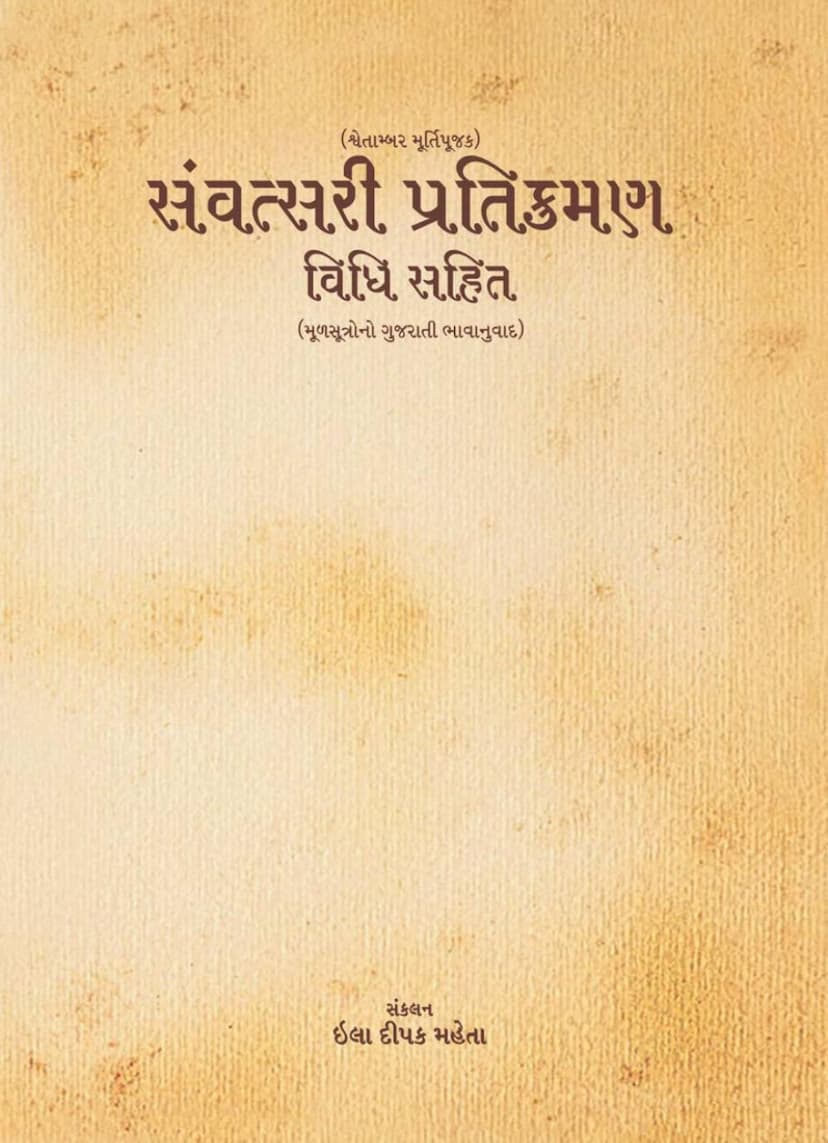Samvatsari Pratikraman Gujarati
Added to library: September 2, 2025

Summary
Based on the provided Gujarati text, here's a comprehensive summary in English of the Jain text "Samvatsari Pratikraman Gujarati" by Ila Mehta:
Book Title: Samvatsari Pratikraman Vidhi Sahit (Sanskrit Sutras with Gujarati Translation) Author: Ila Dipak Mehta Publisher: Ila Dipak Mehta Edition: Second Edition, 2015
Overview:
This book, compiled by Ila Dipak Mehta, serves as a comprehensive guide to performing the "Samvatsari Pratikraman," a significant ritual in Jainism, specifically for followers of the Shvetambar Murtipujak tradition. The book provides the Gujarati translation of the original Sanskrit scriptures along with detailed explanations and visual aids (illustrations) to facilitate a deeper understanding and correct execution of the Pratikraman ceremony.
Core Purpose and Content:
The primary aim of this book is to enable practitioners to perform the Samvatsari Pratikraman with proper understanding and devotion. Pratikraman, as explained in the text, is a crucial practice for spiritual purification, repentance of past actions, and strengthening one's commitment to righteous conduct. The Samvatsari Pratikraman, performed annually, is particularly significant for seeking forgiveness and purifying oneself from sins accumulated over the entire year.
The book emphasizes that Pratikraman is not just a ritualistic act but a profound spiritual discipline, akin to a form of Yoga. It highlights the importance of memorizing and understanding the great sutras composed by the Ganadharas (disciples of Tirthankaras). The author, Ila Mehta, embarked on this project to bridge the gap in understanding, especially for younger generations who might be unfamiliar with the intricacies and the underlying philosophy of these sacred practices.
Key Aspects Highlighted:
- Meaning of Pratikraman: The term "Pratikraman" is broken down into "Prati" (back) and "Kraman" (to move), signifying a return from the path of worldly attachments (Asrava) to the path of spiritual discipline and purification (Samvara and Nirjara). It's about correcting oneself from a state of error (par-sthan) back to one's true state of knowledge, perception, and conduct (swa-sthan).
- Significance of Samvatsari Pratikraman: While daily, fortnightly, and quarterly Pratikramans address sins of shorter periods, Samvatsari Pratikraman addresses the cumulative sins of the entire year, emphasizing a thorough cleansing and reconciliation.
- Detailed Ritualistic Guidance: The book meticulously details various aspects of the Pratikraman, including:
- Six Essential Activities: Samayika (meditation), Chauvisthhalo (praise of the 24 Tirthankaras), Vandan (respectful salutation to gurus), Pratikraman (repentance), Kayotsarga (self-discipline and meditation), and Pachchhakhan (vows and resolutions).
- Use of Utensils: It explains the use and significance of various items used during the ritual, such as the "Sthapana-acharya" (a symbolic representation of the guru), "Muhapatti" (a cloth used to cover the mouth as a sign of reverence and to avoid harming minute beings), "Charavalo" (a broom used for symbolic cleaning), and "Katasanu" (a woolen mat).
- Etiquette and Posture: Detailed illustrations and explanations are provided for performing various actions like offering "Khama-samana" (a gesture of seeking forgiveness), performing "Kayotsarga," and handling the "Muhapatti" and "Charavalo" with proper respect.
- Specific Sutras: The book includes the texts of essential sutras like Namaskar, Irriayavahi, Annath, Logassa, and others, along with their meanings. It also includes stotras for Chaitya Vandan, Guru Vandan, and specific hymns like Ajitshanti and Shanti Stotra.
- Illustrations: A significant feature of this book is the inclusion of illustrations demonstrating the correct posture and actions for various ritualistic steps, making it a practical guide for beginners and a reference for experienced practitioners.
- Author's Motivation: Ila Mehta was inspired by her father-in-law's encouragement to use a significant financial gift for a noble cause. Her desire to make the rituals understandable for her children, who were not raised in a Jain environment, led her to undertake this project. The journey of researching and translating the sutras deepened her own understanding and appreciation for Jainism.
- Community Contribution: The author expresses gratitude to various individuals and organizations who supported her in bringing this book to fruition, including her family, spiritual mentors, and scholars. The book aims to be a valuable resource for all Jain devotees to connect more profoundly with their faith.
Overall Impression:
The book is a labor of love and dedication, aiming to demystify and make accessible the complex yet beautiful ritual of Samvatsari Pratikraman. It serves as a bridge between ancient Jain traditions and the modern seeker, fostering a deeper connection with the spiritual essence of the Pratikraman. The combination of Gujarati translation, detailed explanations, and helpful illustrations makes it a comprehensive and invaluable resource for the Jain community.